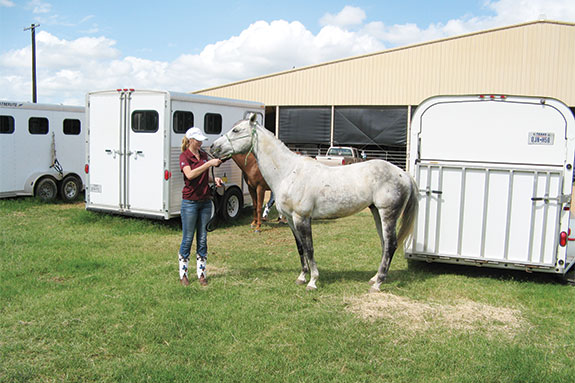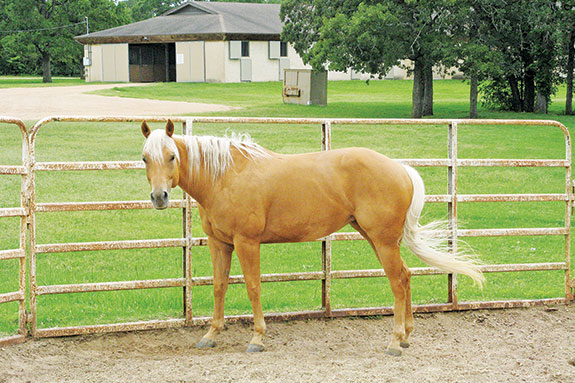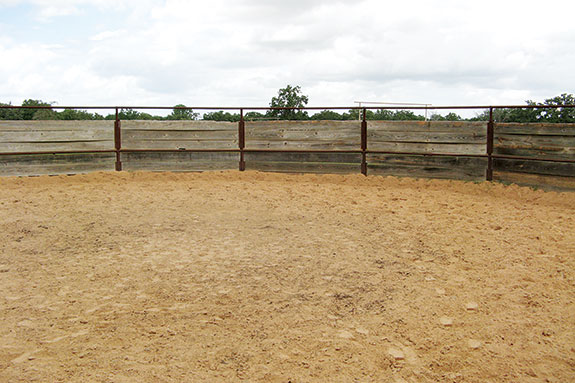At roundup time, horses are expected to work long hours for several days at top performance without any preconditioning.
Like people, horses need exercise to stay fit. We can’t lie on the couch watching television all year and then expect to finish the Boston Marathon without first getting our body in good physical condition.
Likewise, we cannot leave a horse in the pasture all year and then work it hard during roundup without the risk of serious consequences.
“All horsemen should have a good understanding of basic conditioning concepts,” says Dennis Sigler, Ph.D., a horse specialist with Texas A&M AgriLife Extension Service.
“Far too many horses have to be pulled out of the working string because they have been pushed too hard, too fast and were not physically fit to do what the rider asked of them.”
Building physical fitness, of either a horse or a person, involves conditioning the cardiovascular and musculoskeletal systems.
Cardiovascular conditioning improves the ability of the heart and lungs to work together to fuel the body with oxygen, deliver blood to the muscles and remove metabolism byproducts. The cardiovascular system gives the musculoskeletal system ability to function.
Musculoskeletal conditioning enhances muscle strength, endurance and flexibility. Strength is the amount of force a muscle can exert in a single effort, and endurance is the ability of a muscle to perform a continuous effort without fatiguing. Flexibility is the ability of each joint to express its full range of motion.

Basic conditioning principles
“Cardiovascular and musculoskeletal conditioning involves two basic principles: overload and exercise specificity,” Sigler states. “The overload principle is the basis for all conditioning responses.
This means that the system must be overloaded in some manner, such as intensity, speed or time, in order to elicit a response.
“Basically, when the system is overloaded, it relays that fact to the rest of the body and passes on the message, ‘Hey, that hurts and we should get better prepared in case it happens again.’
“Another important concept of the overload principle is there must be a continued workload increase for continued physical fitness improvement. Otherwise, the horse reaches a plateau of fitness relative to the current level of physical exertion and stays at that level.
Gradually increasing the workload is the only way we can get a horse progressively more fit. Of course, if we overload the system too much or too quickly, serious breakdowns can occur before they become fit.”
The other principle of conditioning is exercise specificity, Sigler explains, where the horse should be conditioned to the type of athletic activity it will perform. Cutting horses, for example, do plenty of stops and turns in practice, similar to the activity they will be doing at the actual competition.
So while they are learning to turn and stop with a cow, they are also getting more fit for the specific type of exercise for which they are being trained. In all events or activities, we must be sure horses are conditioned to do the type of exercise they will be asked for in actual competition.
How many barrel horses are exercised every day at a long trot and then go to a jackpot barrel race or a practice session and make two or three hard runs at a full gallop? (A long trot is faster than a jog trot but slower than a lope.)
Ranch horses that have only been long-trotted and slow-galloped on the ranch may not be physically fit to go to a roping on the weekend and run 10 or 12 hard steer-roping runs in a row. The horse should not be asked to perform at a level in competition they have not done at home.
How long does the conditioning process take? “With the right kind of training, we can actually get significant cardiovascular conditioning in as little as four weeks. It takes much longer than that to get bones, tendons and ligaments conditioned.

Normally, it is recommended to condition a horse using nine to 12 weeks of slow, long-distance type exercise before introducing any speed work,” says Sigler.
“Once past this period, we can gradually start introducing speed work one to two times per week in order to get the horse over the anaerobic threshold and to begin to get more bone density and strength,” continues Sigler.
After three to four weeks of gradually introduced speed work, the horse can be put on an interval training schedule, which involves a combination of distance work and speed work. Interval training continues to build aerobic capacity as well as strength and speed.
Back at the ranch
“Horses need to be kept in good body condition as well as physically fit,” says Greg Coalson, who breeds, raises and trains cutting horses on the Coalson Ranch near Weatherford, Texas. “Giving horses the right amount of feed is very important.
They shouldn’t be underfed – nor should they be overfed. If they are not being worked, good pasture grass is sufficient. During heavy work periods, supplement pasture forage with alfalfa hay and rolled oats.

“Keep horses fit by maintaining good lung capacity and muscle tone,” Coalson continues. “A horse should be ridden at least once every 10 days to prepare him for ranch work.
I prefer to exercise them by long trotting for a long distance in a straight line across a pasture.
A horse is well-balanced in a long trot. All four feet are placed on the ground in the same position with equal weight distributed to each leg.
“Properly cooling a horse after exercise is as important as the exercise itself,” cautions Coalson. “When the horse is drenched in sweat and breathing hard, you don’t tie him to a fence and walk off.
Spray his head and hips with water, while he is still saddled, to cool him down. Walk him until he begins to breathe normally. Failure to follow these procedures can result in the horse’s muscles becoming stiff due to overproduction of lactate. The horse can remain crippled the rest of its life.” ![]()
Robert Fears is a freelance writer based in Texas.
PHOTOS
TOP: The more horses you have, the more time required for keeping them fit.
MIDDLE TOP: Be sure your horse is conditioned for the task when entering into competitive events.
BOTTOM MIDDLE and BOTTOM: A round pen is a good facility for exercising horses kept in pens or stables. Photos by Robert Fears.








